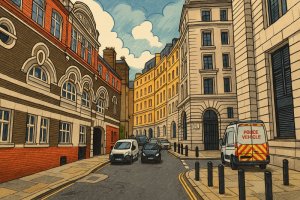
Great Scotland Yard, London

Painting of Great Scotland Yard, London
Great Scotland Yard is a historic street in Westminster, London, connecting Whitehall to Northumberland Avenue. Despite its modest length, this street holds significant historical importance. In the 16th century, it served as the location for buildings used by diplomatic representatives of the Kingdom of Scotland, effectively acting as the Scottish embassy. This association led to the name "Scotland Yard," which later became synonymous with the headquarters of the Metropolitan Police Service.
In the 19th century, the Metropolitan Police Service established its headquarters at 4 Whitehall Place, with the public entrance located on Great Scotland Yard. This entrance became the public face of the police, and over time, "Scotland Yard" became a metonym for the Metropolitan Police Service itself.
The location of Great Scotland Yard in relation to St James's and Whitehall can be a bit confusing because though it is usually said to be within St James's, it is geographically located outside St James's. This is due to historical and administrative factors. The St James's ward of Westminster historically extended further east than what modern maps might suggest. Older records often included parts of the Whitehall area within "St James's." Before modern boundary changes, many areas near Whitehall were administratively part of St James's parish rather than Whitehall.
Many sources historically grouped streets near Trafalgar Square and Whitehall into the broader "St James's" district. Great Scotland Yard, though east of Whitehall, may have been considered part of St James's due to its proximity to St James's Park and government offices traditionally linked to the area.
Today, Whitehall is often thought of as the government district centered on Whitehall road and its ministries, rather than a distinct neighborhood with a large footprint. Great Scotland Yard falls into what many now classify as Whitehall rather than St James's, but older references might still place it within St James's.
The street has been home to notable figures, including architects Inigo Jones and Sir Christopher Wren, as well as the poet John Milton. In modern times, the former police buildings have been transformed into the five-star Great Scotland Yard Hotel, preserving the Edwardian architecture and historical significance of the site.
Origin of the name
How the street Great Scotland Yard got its name is not obscure. The likelihood is that the kings of Scotland used to own properties here prior to the 1707 Union of England and Scotland. Another theory is that a person named Scott lived or owned the property here during the Middle Ages. In any case, Great Scotland Yard has its share of famous people living there including architects Inigo Jones and Christopher Wren as well as poet John Milton.
How to reach Great Scotland Yard
Great Scotland Yard is accessible via the London Underground, with Charing Cross station being the nearest. The station is served by the Bakerloo and Northern lines, and the street is approximately a 5-minute walk from the station.
Fun Facts
The street has also been featured in various films, including "Atonement," "Harry Potter and the Deathly Hallows - Part 1," "Skyfall," and "Doctor Strange," highlighting its iconic status in London's landscape.